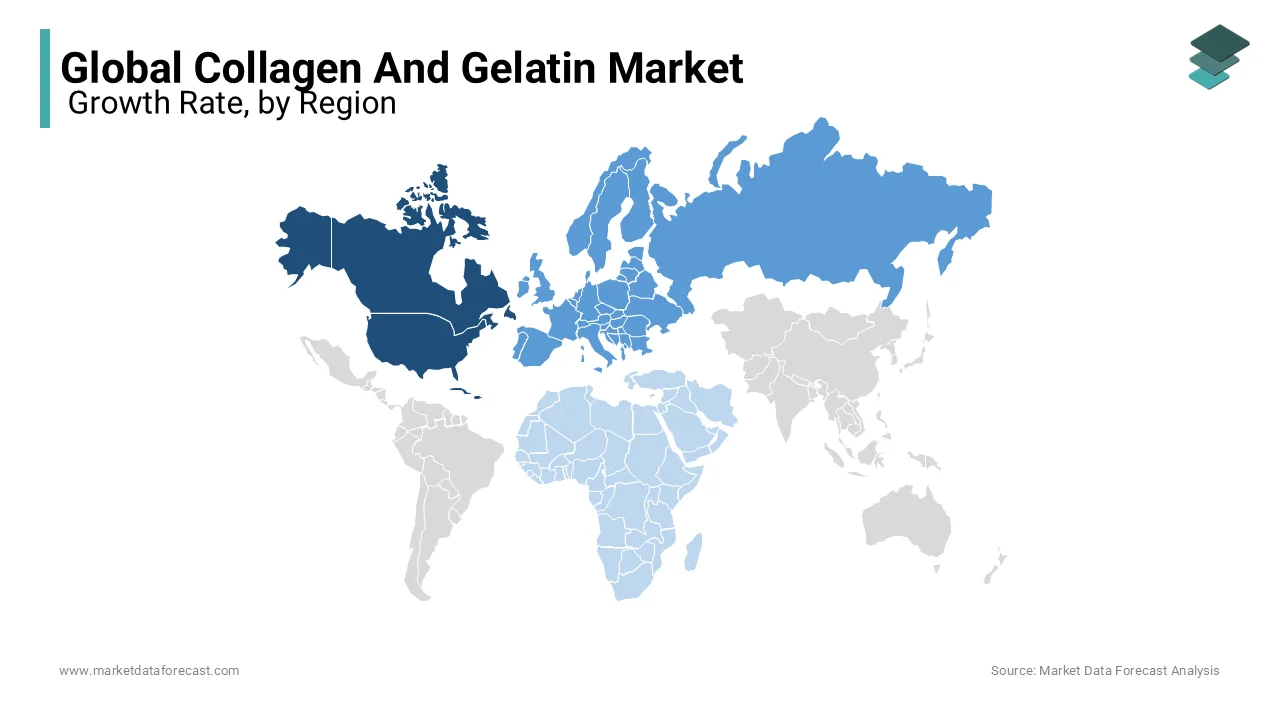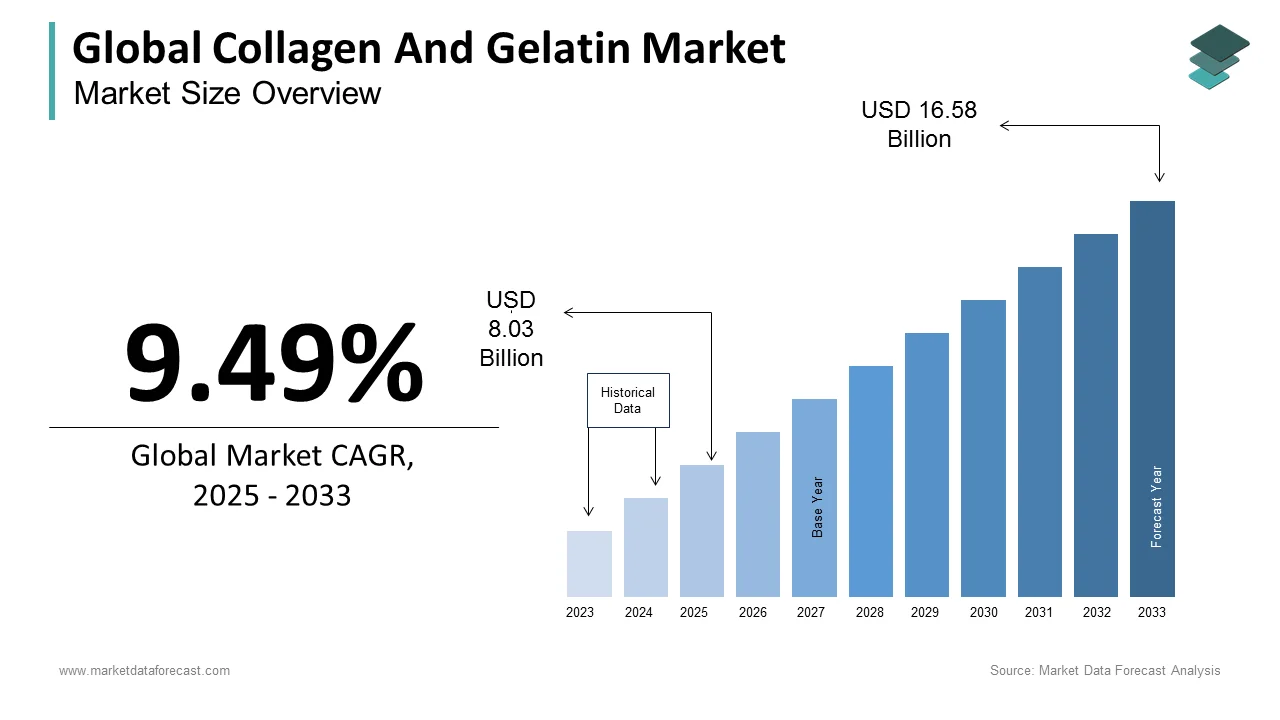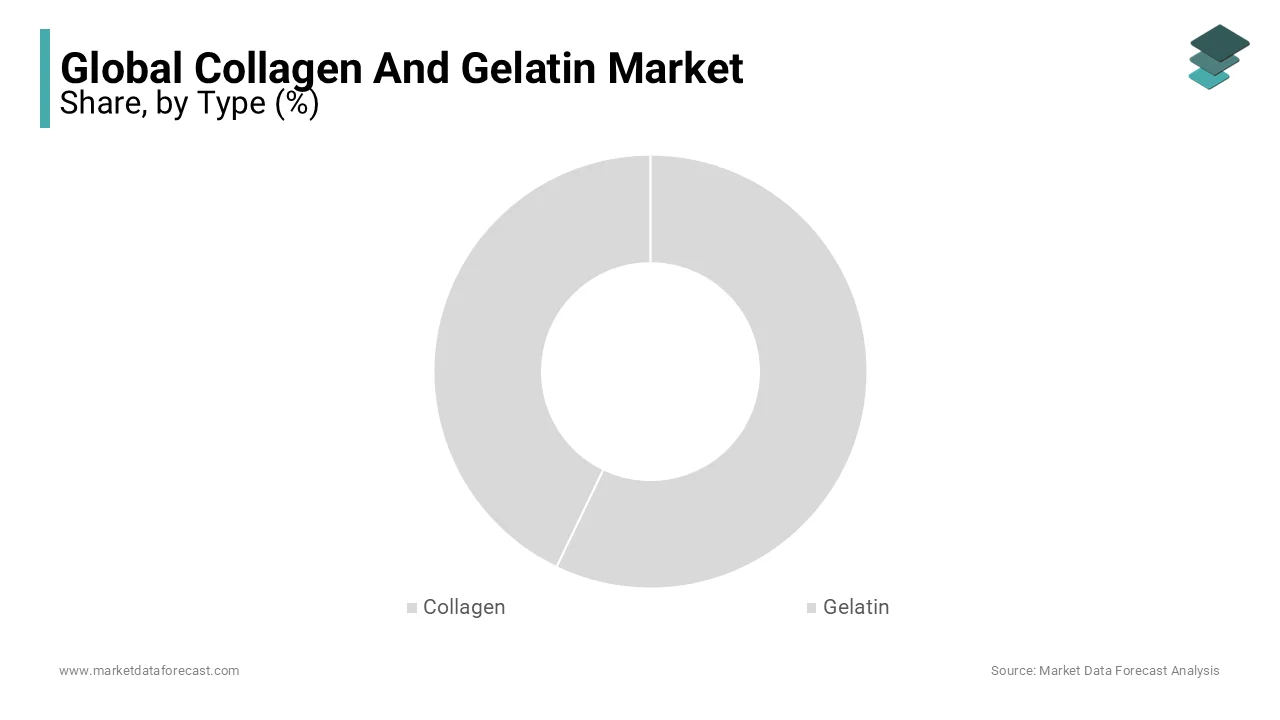Global Collagen and Gelatin Market Size, Share, Trends & Growth Forecast Report By Type (Collagen and Gelatin), Product (Bovine, Porcine and Marine), Application (Wound Care, Orthopedic and Cardiovascular) and Region (North America, Europe, Asia-Pacific, Latin America, Middle East and Africa), Industry Analysis From 2025 to 2033.
Global Collagen and Gelatin Market Size
The size of the global collagen and gelatin market was worth USD 7.33 billion in 2024. The global market is anticipated to grow at a CAGR of 9.49% from 2025 to 2033 and be worth USD 16.58 billion by 2033 from USD 8.03 billion in 2025.
Collagen and gelatin can be present all over the human body, but they're more concentrated in the skin and bones. Collagen activity in the body naturally declines after a certain age. Chronic conditions such as osteoporosis, which causes bone and joint pain, chronic wounds, coronary disease, and other neurodegenerative disorders, are caused by collagen deficiency. The structure of collagen has been examined using a variety of contemporary methods. Nevertheless, care should be used when interpreting the raw data. The best conditions for extraction and collagen structure can differ depending on the source and the time of year. Since they have similar nutritional profiles, they boost joint, hair, liver, skin, and bone health. In the food and beverage industry and the preparation of medications, gelatin is used as a gelling agent in the food industry and in the treatment of various drugs. The product is an essential human protein with many dietary, skin, and health advantages. Furthermore, the gelatin used to treat wounds has a soothing effect and is non-adhesive to wound tissues, allowing for faster wound healing.
MARKET DRIVERS
Growth in Regenerative Medicine
The use of gelatin and collagen-based biomaterials in regenerative medicine has been heavily promoted in recent years. As a result, this technique is now being used on a larger scale for medical and environmental purposes, accelerating the global collagen and gelatin market growth. The rise in demand for gelatin as a food stabilizer causes an increase in food products such as pasta, ice creams, yogurts, jams, and other related goods, the primary driver of the gelatin market growth. In addition, collagen is used for wound treatment and the preparation of multiple medicines, so there was a lot of demand in the collagen and gelatin market. As a result, several researchers have used in vitro and in vivo test models to examine the bioactivities and biological consequences of collagen, gelatin, and their hydrolysis peptides. In addition to collagen's well-established nutritional value as a source of protein, collagen and products derived from it may have several potential biological effects on extracellular matrix cells after ingestion via the corresponding food-derived peptides, which could support their use in dietary supplements and pharmaceutical formulations.
Growth in Cosmetics & Health
The growing use in the food and beverage sector and increased demand from the cosmetics industry are further boosting the growth of the collagen and gelatin market worldwide. Over the last few decades, collagen and gelatin-based biomaterials in regenerative medicine applications have increased dramatically. Because of their main advantages of being biodegradable, biocompatible, readily usable, low immunogenicity, and highly flexible, collagen and gelatin are commonly used in scientific and medical applications, fueling the development of the collagen and gelatin market. Collagen improves skin texture by keeping the skin firm and elastic and helps eliminate the problems of wrinkles and dryness since more wrinkles and dry skin is observed due to less collagen. It not only aids weight loss but also helps in the reduction of body fat, along with reduced inflammation by improving gastrointestinal health. This makes collagen an essential product for daily use.
Growth Driven by Innovation & Aging Populations
Many new applications have been found for collagen and gelatin, which is anticipated to fuel the growth rate of the global collagen and gelatin market in the coming years. Due to recent advancements, collagen supplements have been introduced due to their link with daily intake to improve skin hydration, hair, and nails, increase elasticity, reduce wrinkles, and reduce joint pain and its symptoms. Moreover, due to the increase in research methodologies in the market, collagen has been found to increase bone mineral density, prevent bone loss, and thus prevent atherosclerosis since collagen provides an excellent structure to arteries.
Gelatin has many advantages, which often are not provided by collagen. One such benefit is its application in making the most critical component for desserts like mousse, homemade gummy bears, panna cotta, or gelatin shots when Gelatin gels get cooled down. The aging population in some emerging markets presents a significant opportunity for expanding the collagen and gelatin market. Furthermore, increased research and development funding would support the growth of the collagen and gelatin markets. Emerging economies such as Asia-Pacific and Latin America offer major business prospects due to life expectancy, leading to chronic diseases and increased meat production.
MARKET RESTRAINTS
Disease Risks & Alternative Biomaterials
The risk of disease transmission from collagen obtained from bovine and porcine sources is a serious obstacle to the collagen and gelatin market. The risk of disease transmission from collagen sourced from cows and pigs is a major challenge for the collagen and gelatin market. Concerns mainly focus on Bovine Spongiform Encephalopathy (BSE) which is a serious brain disease in cattle that could potentially infect humans through contaminated products. Studies indicate that collagen is usually extracted from skin or tendons has a low chance of spreading BSE which is the seriousness of the illness requires caution. Regulatory agencies closely monitor animal-derived materials will affects how manufacturers operate and their ability to access markets. Additionally, consumer awareness and fears about food safety can lead to reduced sales shall hinder the market growth. Companies must adopt strict sourcing and quality control practices to reduce these risks and assure buyers about product safety.
In addition, the rising use of biomaterials that are alternatives to Collagen and Gelatin is a significant challenge to the global collagen and gelatin market growth. The growing use of biomaterials that can replace collagen and gelatin is a significant challenge for the global market. As research progresses, new options like plant-based proteins, synthetic materials, and bioengineered substances are becoming more popular due to their sustainability and ethical sourcing. These alternatives often attract health-conscious consumers and those with dietary restrictions, such as vegans and vegetarians, who prefer non-animal products. Furthermore, advancements in technology enable the creation of substitutes that effectively mimic the properties of collagen and gelatin. As a result, companies in the traditional collagen market need to innovate and adapt to stay competitive in this changing environment. Maintaining relevance will be crucial as consumer preferences evolve toward these new materials.
MARKET OPPORTUNITIES
Advancements & Eco-Friendly Trends
The growth of the collagen and gelatin market appears promising. This can be credited to the advancement in delivery systems. Traditional supplements for this generally faces problems related to bioavailability and absorption. Creations such as microencapsulation can safeguard this protein peptides from digestive enzymes. This allows the delivery to target tissues to be more effective. Furthermore, market player can also employ nono-technology to make nano-particles for enhancing its constancy and absorption in the gastrointestinal tract. These modern systems for administration can improve the productivity of these structural protein products. Hence, making them greatly attractive to customers wanting tangible health advantages.
Collaboration with biotechnology is another factor providing potential growth prospective for this market. Association with bioengineering companies can bring key breakthroughs in producing superior-quality gelatin using fermentation or synthetic biology. These approaches can make collagen without depending on animal sources by addressing ethical concerns and tenability problems. For instance, bacteria or yeast can be engineered to create connective tissue proteins which imitate the structure and function of a natural one. So, this method not only lowers ecological effect but also presents new market for vegan and vegetarian consumers.
Considering the trend and inclinations around the world eco-friendly manufacturing practices for sustainable sourcing can significantly influence the market expansion in the coming years. With people becoming more environmentally aware, companies can take this opportunity to accept viable sourcing practices for production in this market. Utilizing by-products from the food industry—such as fish skins or bones from meat processing—can reduce waste while providing high-quality raw materials for collagen extraction. This not only helps minimize environmental impact but also appeals to consumers who prioritize sustainability in their purchasing decisions.
MARKET CHALLENGES
Production Challenges & Regulatory Hurdles in Collagen
Production difficulties are one of the key challenges hindering the growth of the collagen and gelatin market. Its yield, particularly using traditional extraction approaches from animal sources, usually result in low harvests. This is because of the complicated procedures involved in isolating collagen from tissues like cartilage, bones, or skin. Also, high cost of production can restrict the scalability of these products. This makes them less accessible for extensive application in industries like cosmetics and pharmaceuticals. Moreover, the market growth is influenced by the synthesis complications. It is a complex protein that undergoes several post-translational modifications, comprising glycosylation and hydroxylation, which are important for its function and stability. The challenge is to replicate these processes in vitro or via recombinant techniques. Existing recombinant technologies may not completely imitate its native structure and operation ability, resulting in products that differ significantly from natural collagen.
Regulatory obstacles are another set of constraints impeding the market growth rate. The legal landscape for gelatin and collagen items varies by regions. But, they frequently requires comprehensive testing for efficacy and safety before market approval. Sailing through these legislations can be intricate and time-taking, delaying product availability. So, makers must remain updated with the changing rules and make sure of their goods satisfy all necessary standards. Related to this, clinical validate is also a notable issue for the market players. Various new collagen-based treatments call for in-depth clinical tests to exhibit their success in humans.
REPORT COVERAGE
|
REPORT METRIC |
DETAILS |
|
Market Size Available |
2024 to 2033 |
|
Base Year |
2024 |
|
Forecast Period |
2025 to 2033 |
|
Segments Covered |
By Type, Product, Application, and Region. |
|
Various Analyses Covered |
Global, Regional & Country Level Analysis, Segment-Level Analysis; DROC, PESTLE Analysis, Porter's Five Forces Analysis, Competitive Landscape, Analyst Overview of Investment Opportunities |
|
Regions Covered |
North America, Europe, APAC, Latin America, Middle East & Africa |
|
Market Leader Profiled |
LifeSciences Holding Corporation (U.S.), Collagen Solutions plc (U.K.), Vornia Biomaterials, Ltd. (Ireland), Collagen Matrix, Inc. (U.S.), GELITA AG (Germany), Nitta Gelatin, Inc. (Japan), and PB Gelatin (Belgium), Royal DSM (Netherlands), Integra SYMATESE (France), and NuCollagen, LLC. (U.S.)., and Others. |
SEGMENTAL ANALYSIS
By Type Insights
The gelatin segment is predicted to occupy a significant share in the global collagen and gelatin market during the forecast period due to the growing demand among the food and pharmaceutical industries owing to the outstanding stabilizing features and binding characteristics. Also, growing awareness regarding protein consumption among the general population and increasing bakery products worldwide has led to the gelatin market. Gelatin is a thickening ingredient used in desserts and other foods. It has no flavor and is white. Animal bones, skin, and connective tissue include collagen, which is produced from that material and marketed in processed form for use in cooking.
Collagen is expected to dominate the collagen and gelatin market owing to the rise in the elderly population, leading to decreases in the amount of collagen in the body, which increases the risk of degenerative joint disorders such as osteoarthritis. According to some studies' suggestions, this leads to an increase in the adoption of collagen supplements since they may help reduce overall joint pain and improve osteoarthritis symptoms.
By Product Insights
Among these segments, porcine collagen has acquired a significant share of the global collagen and gelatin market in the recent past. At the same time, Marine collagen is further expected to grow with a high CAGR over the forecast period due to the increasing fish production worldwide. Besides, the rapid adoption of fish collagen worldwide because of the rising cosmetic industry worldwide is another crucial factor in augmenting the Marine segment's growth during the forecast period. Marine, or fish, collagen is obtained from fish skin, which is absorbed up to 1.5 times more efficiently in the body. Therefore, more people have turned to fish collagen since it has higher bioavailability than bovine or porcine types due to its smaller particle size compared to other types of collagen.
Bovine collagen is also estimated to hold a significant market share due to its wide range of benefits of improving skin elasticity, reducing signs of aging, and improving joint, back, and knee pain by increasing the density of age-weakened bones. This form of collagen is obtained from cows primarily by boiling bovine bones and by-products in water to extract the collagen. Similar to the collagen in the human body, bovine collagen provides a flexible structure, helping in its strengthening and hardening, making bones strong and flexible enough to withstand stress, primarily through a combination of collagen and calcium.
By Application Insights
Among all these applications, orthopedics has a considerable share of the market. Due to its chemotactic properties, which draw fibroblasts to the wound site, collagen is essential for all stages of wound healing.
However, wound care and cardiovascular segments are expected to grow significantly due to the integrated benefits of collagen and gelatin. Collagen encourages the development of new blood vessels, granulation tissue, wound debridement, and the ability of the wound to re-epithelize.
REGIONAL ANALYSIS
In the regional analysis, North America had the largest share of the global market in 2024 and the lead of the region is estimated to continue throughout the forecast period owing to the presence of developed markets such as the USA.

During the forecast, Europe is anticipated to constantly increase its growth rate due to high demand for functional food products, rapid increase in the pharmaceutical and nutraceutical industries, and gelatin-based cosmetics products for personal care. In addition, gelatins are used in many biomedical applications with controlled endotoxin levels, which is an excellent help for embolization, wound healing, drug delivery, and haemostatics. Furthermore, the newly launched gelatin products with the offerings of controlled endotoxin levels, biodegradability, biocompatibility, and batch-to-batch consistency by various manufacturers in the market are further expected to drive the regional market. Moreover, Germany is expected to dominate the market owing to the growth of the country's food industries with heavy collagen use and the growing acceptance of collagen in various applications, such as cosmetics and dietary supplements.
At the same time, the Asia Pacific region is expected to grow significantly, with the highest CAGR over the forecast period. The rising number of food manufacturers and the growth of the food processing industry, especially in emerging markets like China and India, are the significant factors that boost the development of the target market in the coming years. Also, factors like the growing importance of nutrition & personal well-being, rapid industrialization, increase in personal care spending, and the abundant availability of raw material for collagen & gelatin production are the other significant factors driving the growth of the Asia Pacific market.
Latin America is anticipated to grow steadily during the forecast period.
The Middle East and Africa is expected to register a moderate CAGR from 2025 to 2033.
KEY MARKET PARTICIPANTS
Some of the prominent companies operating in the global collagen and gelatin market profiled in the report are LifeSciences Holding Corporation (U.S.), Collagen Solutions plc (U.K.), Vornia Biomaterials Ltd. (Ireland), Collagen Matrix, Inc. (U.S.), GELITA AG (Germany), Nitta Gelatin, Inc. (Japan), P.B. Gelatin (Belgium), Royal DSM (Netherlands), Integra SYMATESE (France), NuCollagen, LLC. (the U.S.)
RECENT HAPPENINGS IN THE MARKET
- In November 2024, the Brazilian Government reported that it had received approval from Peru for the sanitary needs for importing nonfoodstuff bovine bone collagen and gelatin from Brazil. This achievement signifies the tenth market access milestone attained for Brazilian agribusiness goods in Peru in the past year. From January 2023 through October 2024, Brazilian agricultural exports to Peru exceeded 1.27 billion dollars, with major exports including forestry items, meat, and soybeans.
- In October 2024, Gelita, via a press release, revealed its recent scientific research on PETAGILE Bioactive Collagen Peptide (BCP). It was also published in the esteemed journal PLOS One. This systematic study designed as placebo-controlled and double-blind, validates the remarkable effectiveness of PETAGILE in reducing symptoms associated with canine osteoarthritis (OA). Further, the research indicates that administering PETAGILE orally can lead to notable enhancements in mobility and a reduction in OA symptoms in dogs within a mere 12 weeks, surpassing existing nutritional approaches that incorporate Omega-3 fatty acids and Vitamin E.
- In May 2024, Nitta Gelatin India Limited (NGIL) reported the expansion of its collagen peptide project by organising an inauguration ceremony at the factory in Kakkanad (India). In addition, NGIL is formed through a joint collaboration of the Kerala State Industrial Development Corporation and Nitta Gelatin from Japan. The expansion plan encompasses an investment totalling 200 crore rupees. Moreover, Nitta Gelatin group stands as one of the top producers in this market worldwide, addressing the needs of the food and pharmaceutical industries. Also, a new variant aimed at aiding diabetes management is anticipated to be launched soon. The enhanced capacity will adequately fulfil this surging requirement.
MARKET SEGMENTATION
This global collagen and gelatin market research report has been segmented and sub-segmented into the following categories.
By Type
- Collagen
- Gelatin
By Product
- Bovine
- Porcine
- Marine
By Application
- Wound Care
- Orthopedic
- Cardiovascular
By Region
- North America
- Europe
- Asia-Pacific
- Latin America
- Middle East and Africa
Frequently Asked Questions
At What CAGR, the global collagen and gelatin market is expected to grow from 2025 to 2033?
The global collagen and gelatin market is estimated to grow at a CAGR of 9.49% from 2025 to 2033.
Who are the major players operating in the global collagen and gelatin market?
LifeSciences Holding Corporation (U.S.), Collagen Solutions plc (U.K.), and Vornia Biomaterials Ltd. (Ireland) are some of the major players in the collagen and gelatin market.
How much is the global collagen and gelatin market going to be worth by 2033?
As per our research report, the global collagen and gelatin market size is estimated to grow to USD 16.48 billion by 2033.
Related Reports
Access the study in MULTIPLE FORMATS
Purchase options starting from $ 2500
Didn’t find what you’re looking for?
TALK TO OUR ANALYST TEAM
Need something within your budget?
NO WORRIES! WE GOT YOU COVERED!
Call us on: +1 888 702 9696 (U.S Toll Free)
Write to us: [email protected]


